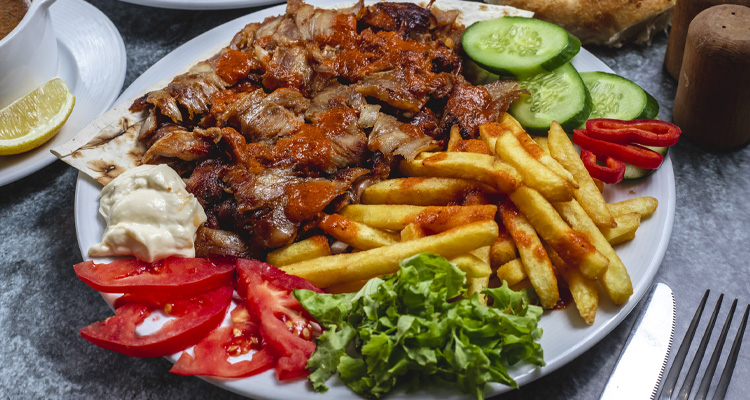Greek Gyro, with its aromatic spices, tender meat, and vibrant accompaniments, is a culinary masterpiece that tantalizes taste buds worldwide. Rooted in ancient Greek traditions, this dish has evolved into a global favorite. Join us as we delve into the world of Greek Gyro, exploring its rich history, diverse preparations, and the sheer delight it brings to every meal.
Nutrition Facts
- Kcal
380 - Fat
18 g - Choles
85 mg - Sodium
400 mg - Carbs
28 g - Fiber
2 g - Sugar
4 g - Protein
26 g
Note: The nutrition facts are approximate values and may vary based on the specific ingredients used and any additional toppings or syrups added.
Ingredients
- 1 lb (450g) lamb or beef, thinly sliced
- 4 pita bread rounds
- 1 cup Greek yogurt
- 1 cucumber, finely diced
- 1 tomato, thinly sliced
- 1/2 red onion, thinly sliced
- 1/4 cup fresh parsley, chopped
- 2 cloves garlic, minced
- 2 tablespoons lemon juice
- 2 tablespoons olive oil
- 1 teaspoon dried oregano
- Salt and black pepper to taste
Directions
- Prepare the Meat: In a bowl, combine the sliced lamb or beef with minced garlic, oregano, salt, black pepper, and 1 tablespoon of olive oil. Toss to coat the meat evenly. Let it marinate for at least 15 minutes.
- Prepare Tzatziki Sauce: In another bowl, mix Greek yogurt, diced cucumber, half of the minced garlic, half of the lemon juice, and a pinch of salt. Stir well and refrigerate until serving.
- Cook the Meat: Heat a non-stick skillet over medium-high heat. Add the marinated meat and cook until browned and cooked through, about 3-4 minutes per side. Remove from heat and set aside.
- Warm the Pita: In the same skillet, warm the pita bread rounds for about 1 minute on each side until they are slightly toasted and pliable.
- Assemble the Gyros: On each warm pita, place a portion of the cooked meat. Top with sliced tomatoes, red onions, and a generous dollop of tzatziki sauce. Sprinkle with fresh parsley and drizzle with the remaining olive oil and lemon juice.
- Wrap and Serve: Fold the pita around the fillings, creating a gyro wrap. Secure with parchment paper or foil if needed. Serve immediately.
The Origins of Greek Gyro: A Taste of History
Ancient Roots and Modern Marvels
Greek Gyro has its roots in ancient Greece, where slices of seasoned meat were cooked on vertical rotisseries. The word "gyro" itself means "turn" in Greek, reflecting the cooking method. Today, this tradition lives on, with modern interpretations that combine age-old techniques with contemporary flavors.
Crafting the Perfect Gyro: A Culinary Art
The Meat: A Symphony of Flavor and Tenderness
The heart of every gyro lies in its meat. Traditionally, lamb, beef, or a combination of both is marinated with a blend of Mediterranean spices like oregano, garlic, and thyme. The meat is then stacked onto a vertical rotisserie, where it slowly cooks to succulent perfection, capturing the essence of Greek culinary expertise.
Pita Perfection: The Pillowy Encasement
A gyro's journey isn't complete without the perfect pita. Soft, warm, and slightly charred, the pita acts as the vessel for the flavorful meat. It cradles the slices of gyro, creating a delightful contrast of textures and flavors with every bite.
Varieties of Greek Gyro: Exploring Delightful Options
Traditional Lamb Gyro: A Classic Delight
The classic Lamb Gyro, with its tender slices of marinated lamb, fresh veggies, and tangy tzatziki sauce, is an authentic Greek experience. The harmony of flavors creates a culinary symphony that transports you straight to the streets of Athens.
Chicken Gyro: A Lighter Alternative
For those seeking a lighter option, Chicken Gyro is a popular choice. Marinated chicken, grilled to perfection, is paired with crisp vegetables and creamy sauces, offering a refreshing twist on the traditional gyro.
Vegetarian Gyro: Embracing Plant-Based Bliss
Vegetarian Gyro caters to the herbivores, featuring grilled vegetables, falafel, or tofu as the star ingredient. With the same aromatic spices and fresh accompaniments, it captures the essence of Greek Gyro without the meat.
How to Enjoy Greek Gyro: Tips and Etiquette
Savoring Every Bite: A Gastronomic Journey
When indulging in a gyro, embrace the experience. Hold the gyro firmly, ensuring no delectable filling escapes, and take a hearty bite. The explosion of flavors and textures is meant to be savored, making each moment a celebration of culinary artistry.
Accompaniments: The Perfect Pairings
Greek Gyro is often served with a variety of accompaniments, such as fresh tomatoes, onions, lettuce, and cucumbers. Topped with a generous dollop of tzatziki sauce, the gyro achieves a harmonious balance of flavors. Don't forget to pair it with classic Greek sides like olives and feta cheese for an authentic experience.
Making Greek Gyro at Home: A Flavorful Adventure
Marinating the Meat: Infusing Flavors
Begin by marinating your choice of meat with a blend of olive oil, garlic, lemon juice, and Mediterranean spices. Allow it to marinate for a few hours, ensuring the flavors seep into the meat, creating a tantalizing aroma.
Grilling to Perfection: The Art of Char
Grill the marinated meat to perfection, allowing it to acquire a slightly charred exterior while remaining tender and juicy inside. Slice it thinly, ready to be enveloped in warm pita bread.
FAQs About Greek Gyro
Is gyro the same as a shawarma?
While both gyro and shawarma involve meat cooked on a vertical rotisserie, the seasoning and accompaniments differ, giving each dish its distinct flavor profile.
What is the origin of tzatziki sauce?
Tzatziki sauce, a classic gyro accompaniment, has Greek origins. It's made with yogurt, cucumbers, garlic, mint, and lemon juice, creating a refreshing and tangy flavor.
Can I make a gyro without a vertical rotisserie?
Certainly! Gyro can be prepared using a grill, stovetop, or oven. While the traditional vertical rotisserie imparts a unique flavor, other methods can still yield a delicious result.
What drinks pair well with Greek Gyro?
Greek Gyro pairs wonderfully with beverages like Greek wine, lemonade, or even a refreshing glass of iced tea. The goal is to balance the richness of the gyro with a complementary drink.
Is Greek Gyro spicy?
The level of spiciness in Greek Gyro can vary. Traditionally, it's not overly spicy, but some variations incorporate spicy sauces or seasonings for an extra kick.
Can I freeze marinated gyro meat for later use?
Yes, marinated gyro meat can be frozen for future use. It allows the flavors to intensify, enhancing the taste when cooked.
Conclusion
Greek Gyro, with its blend of aromatic spices, succulent meat, and fresh accompaniments, offers a gastronomic adventure that transcends borders. Whether you're savoring a classic Lamb Gyro or exploring inventive variations, each bite carries the essence of Greek culinary expertise. As you embark on this flavorful journey, remember, Greek Gyro isn't just a dish; it's a celebration of culture, tradition, and the joy of indulging in the finer tastes of life.













